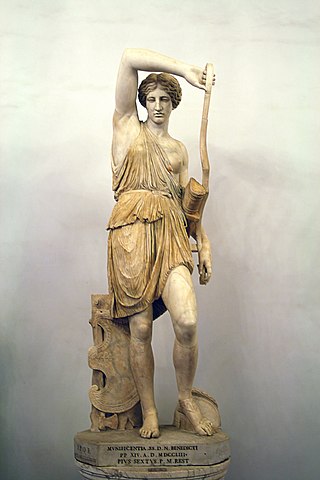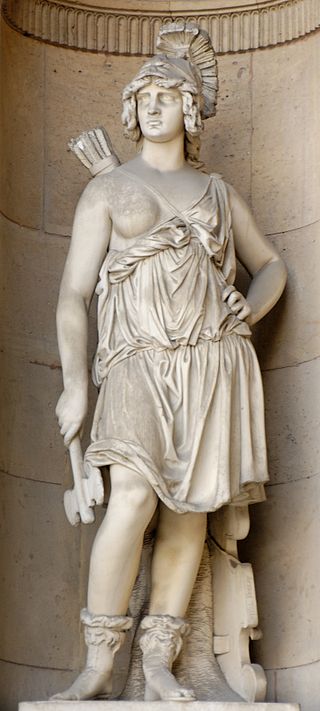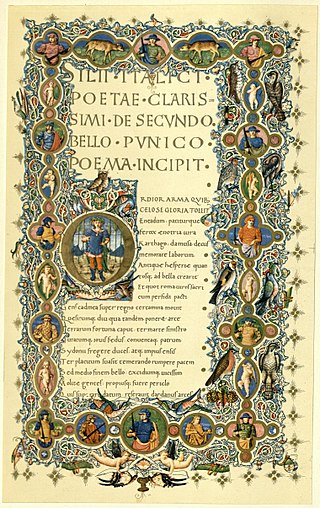Related Research Articles

The Amazons were a people in Greek mythology, portrayed in a number of ancient epic poems and legends, such as the Labours of Heracles, the Argonautica and the Iliad. They were female warriors and hunters, known for their physical agility, strength, archery, riding skills, and the arts of combat. Their society was closed to men and they raised only their daughters and returned their sons to their fathers, with whom they would only socialize briefly in order to reproduce.

Penthesilea was an Amazonian queen in Greek mythology, the daughter of Ares and Otrera and the sister of Hippolyta, Antiope, and Melanippe. She assisted Troy in the Trojan War, during which she was killed by Achilles or Neoptolemus. The asteroid 271 Penthesilea, discovered in 1887, was named in her honor.

Lucius Aemilius Paullus, also spelled Paulus, was a consul of the Roman Republic twice, in 219 and 216 BC. He is primarily remembered for being one of the commanders of the Roman army at the Battle of Cannae, and for his death in the same battle.

The Battle of Himera, supposedly fought on the same day as the Battle of Salamis, or at the same time as the Battle of Thermopylae, saw the Greek forces of Gelon, King of Syracuse, and Theron, tyrant of Agrigentum, defeat the Carthaginian force of Hamilcar the Magonid, ending a Carthaginian bid to restore the deposed tyrant of Himera. The alleged coincidence of this battle with the naval battle of Salamis and the resultant derailing of a Punic-Persian conspiracy aimed at destroying the Greek civilization is rejected by modern scholars. Scholars also agree that the battle led to the crippling of Carthage's power in Sicily for many decades. It was one of the most important battles of the Sicilian Wars.

Tanit or Tinnit was a chief deity of Ancient Carthage; she derives from a local Berber deity and the consort of Baal Hammon. As Ammon is a local Libyan deity, so is Tannit, which she represents the matriarchal aspect of Numidian society, whom the Egyptians identify as Neith and the Greeks identify as Athena. She was the goddess of Wisdom, civilization and the crafts; she is the defender of towns and homes where she is worshipped. Ancient North Africans used to put her sign on tombstones and homes to ask for protection, her main temples in Thinissut, Cirta, Lambaesis and Theveste. She had a yearly festival in Antiquity which persists to this day in many parts of North Africa but was banned by Muammar Gaddafi in Libya, who called it a pagan festival.

Tiberius Catius Asconius Silius Italicus was a Roman senator, orator and epic poet of the Silver Age of Latin literature. His only surviving work is the 17-book Punica, an epic poem about the Second Punic War and the longest surviving poem in Classical Latin at over 12,000 lines.

The siege of Saguntum took place in 219 BC between the Carthaginians and the Saguntines at the town of Saguntum, near the modern town of Sagunto in the province of Valencia, Spain. The battle is mainly remembered today because it triggered one of the most important wars of antiquity, the Second Punic War.
Gnaeus Servilius Geminus was a Roman consul, serving as both general and admiral of Roman forces, during the Second Punic War.

During the Iron Age and Classical antiquity, Libya referred to modern-day Africa west of the Nile river. Greek and Roman geographers placed the dividing line between Libya/Africa and Asia at the Nile. In contrast, the areas of Sub-Saharan Africa were known as Aethiopia. Africa in the broad sense that the Greeks called Libya, i.e. the part of Africa bounded by the Nile, the Mediterranean and the Atlantic was one of the three parts of the world of the ancients.
The traditional Berber religion is the sum of ancient and native set of beliefs and deities adhered to by the Berbers. Originally, the Berbers seem to have believed in worship of the sun and moon, animism and in the afterlife, but interactions with the Phoenicians, Greeks and Romans influenced religious practice and melted traditional faiths with new ones.

Brennus or Brennos was an ancient Gallic chieftain of the Senones. In c. 387 BC, he defeated the Romans at the Battle of the Allia. Later that year, he led an army of Cisalpine Gauls in their attack on Rome and captured most of the city, holding it for several months. Brennus's sack of Rome was the only time in 800 years the city was occupied by a non-Roman army before the fall of the city to the Visigoths in 410 AD.

The role of women in ancient warfare differed from culture to culture. There have been various historical accounts of females participating in battle.
Iarbas was a Roman mythological character, who has appeared in works by various authors including Ovid and Virgil. The character is possibly based on a historical king of Numidia.

The Punica is a Latin epic poem in seventeen books in dactylic hexameter written by Silius Italicus, comprising some twelve thousand lines. It is the longest surviving Latin poem from antiquity. Its theme is the Second Punic War and the conflict between the two great generals Hannibal and Scipio Africanus. The poem was re-discovered in either 1416 or 1417 by the Italian humanist and scholar Poggio Bracciolini.
In Roman mythology, Fabius was the son of Hercules and an unnamed mother.
The princess Celtine or Celto is the protagonist of a Celtic ancestral myth that was recorded by several Graeco-Roman authors.
Larus was a leader of Cantabrian mercenaries in the Carthaginian army during the Second Punic War, according to Silius Italicus's poem Punica.
Viriathus was a leader of Gallaecian and Lusitanian mercenaries in the Carthaginian army during the Second Punic War, according to Silius Italicus's poem Punica.

Mercenary life is recorded as a custom of Iron Age Spain, particularly in the central area of the Iberian Peninsula. Departing from the native tribe and applying to serve in others was a way for economically disadvantaged youth to escape poverty and find an opportunity to use their fighting skills. Starting from 5th century BC, mercenary life would become a true social phenomenon in Hispania, with great numbers of fighters from distant lands coming to join the armies of Carthage, Rome, Sicily and even Greece, as well as other Hispanic peoples.

Imilce or Himilce was the Iberian wife of Hannibal Barca according to a number of historical sources.
References
- 1 2 3 Silius Italicus, Punica , 2
- ↑ Adrienne Mayor (2016). The Amazons: Lives and Legends of Warrior Women across the Ancient World. Princeton University Press. ISBN 978-06-911702-7-5.
- 1 2 3 4 Walter Duvall Penrose Jr. (2016). Postcolonial Amazons: Female Masculinity and Courage in Ancient Greek and Sanskrit Literature. Oxford University Press. ISBN 978-01-910880-3-2.
- ↑ Martin T. Dinter, "Epitaphic Gestures in Statius and Silius Italicus", in Antony Augoustakis (ed.), Ritual and Religion in Flavian Epic (Oxford University Press, ), pp. 267–286, at 277.
- ↑ Silius Italicus, Punica, 3